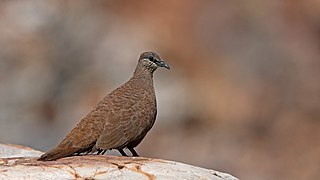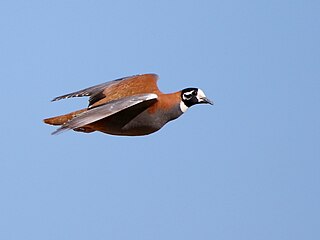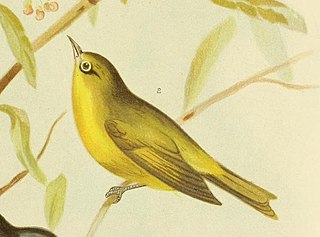
The Top End of Australia's Northern Territory is a geographical region encompassing the northernmost section of the Northern Territory, which aside from the Cape York Peninsula is the northernmost part of the Australian continent. It covers a rather vaguely defined area of about 245,000 square kilometres (95,000 sq mi) behind the northern coast from the Northern Territory capital of Darwin across to Arnhem Land with the Indian Ocean on the west, the Arafura Sea to the north, and the Gulf of Carpentaria to the east, and with the almost waterless semi-arid interior of Australia to the south, beyond the huge Kakadu National Park.

The topknot pigeon is a pigeon native to eastern Australia.

The black falcon is a medium-large falcon that is endemic to Australia. It can be found in all mainland states and territories and yet is regarded as Australia's most under-studied falcon.

Petrophassa, commonly known as the rock pigeons, is a small genus of doves in the family Columbidae native to Australia, and similar to bronzewing pigeons.

The varied lorikeet, is a species of parrot in the family Psittacidae that is endemic to the northern coastal regions of Australia. It is the only species in the genus Psitteuteles.
The Vanuatu imperial pigeon or Baker's imperial pigeon is a species of bird in the family Columbidae. It is endemic to Vanuatu and lives in forests. It is threatened by forest clearing, and the International Union for Conservation of Nature (IUCN) has assessed it as a vulnerable species.

The goliath imperial pigeon, also known as the New Caledonian imperial pigeon and the notou, is a species of bird in the family Columbidae. It is endemic to New Caledonia. Its natural habitat is humid forests. The International Union for Conservation of Nature (IUCN) has assessed it as a near-threatened species.

The white-quilled rock pigeon is a dark brown rock pigeon with a white patch on its wing. It has distinctive pale lines across its face curving above and below its eye. It is a species of bird in the family Columbidae. It is a rock dweller found roosting on sandstone cliffs and towers in the Kimberley, WA and east of the Victoria River, NT. It is endemic to Australia.

The flock bronzewing, also known as the flock pigeon, harlequin bronzewing and the harlequin pigeon is a species of pigeon in the family Columbidae. It is endemic to drier parts of Australia.

The shy heathwren is a species of small bird in the family Acanthizidae, endemic to Australia. They inhabit mostly mallee woodland that has relatively dense shrub and heath understorey.

The bridled honeyeater is a species of bird in the family Meliphagidae with distinctive rein-like markings on its face that is endemic to northeastern Queensland. It is found in subtropical or tropical moist upland forests and subtropical or tropical rainforests, usually above 300 meters. In winter, it descends to lower forests including mangroves, and can sometimes be seen in more open habitats.

The hooded robin is a small passerine bird native to Australia. Like many brightly coloured robins of the Petroicidae, it is sexually dimorphic; the male bears a distinctive black-and-white plumage, while the female is a nondescript grey-brown.

The crested bellbird is a medium-sized passerine bird in the family Oreoicidae. It is native to drier parts of Australia where its typical habitats are acacia scrublands, eucalypt woodlands, spinifex and saltbush plains, and dunes. The male is about 20 cm (8 in) long and has a grey head, a black crest and breast, and a grey or olive brown body. The female and juvenile are similar but the colours are more muted and the black breast is lacking. The distinctive call is a high pitched bell-like sound, audible at some distance. Sometimes a pair of birds duet.

The canary white-eye or yellow white-eye is a species of white-eye endemic to northern Australia in subtropical or tropical mangrove forests. Its common name reflects the circle of white feathers around its eye.
Rock pigeon may refer to:

The Arnhem Plateau is an Australian bioregion located in the Northern Territory of Australia, comprising an area of 2,306,023 hectares of the raised and heavily dissected sandstone plateau that characterises central Arnhem Land in the Top End of the Northern Territory.















